Corporate Innovation and Entrepreneurship: MBA Analysis Report
VerifiedAdded on 2020/10/05
|17
|5483
|214
Report
AI Summary
This report provides a critical analysis of how organizations can effectively structure systems to promote and sustain innovation, creativity, and corporate entrepreneurship to manage change. Focusing on Matchbox Architects (MBA), the report examines the importance of innovation and creative thinking, identifying opportunities and barriers to creativity at both individual and organizational levels. It explores various models such as the Creative Problem-Solving (CPS) Model and Design Thinking, along with convergent and divergent thinking tools. The report recommends strategies to foster creative thinking within MBA, including brainstorming, training, and setting goals, to enhance productivity and sustainability. It emphasizes the creation of a supportive environment and the use of solution-based approaches for problem-solving. The report also provides insights into challenges like individual, people, and environmental blocks, and suggests ways to overcome them to enhance innovation and growth.
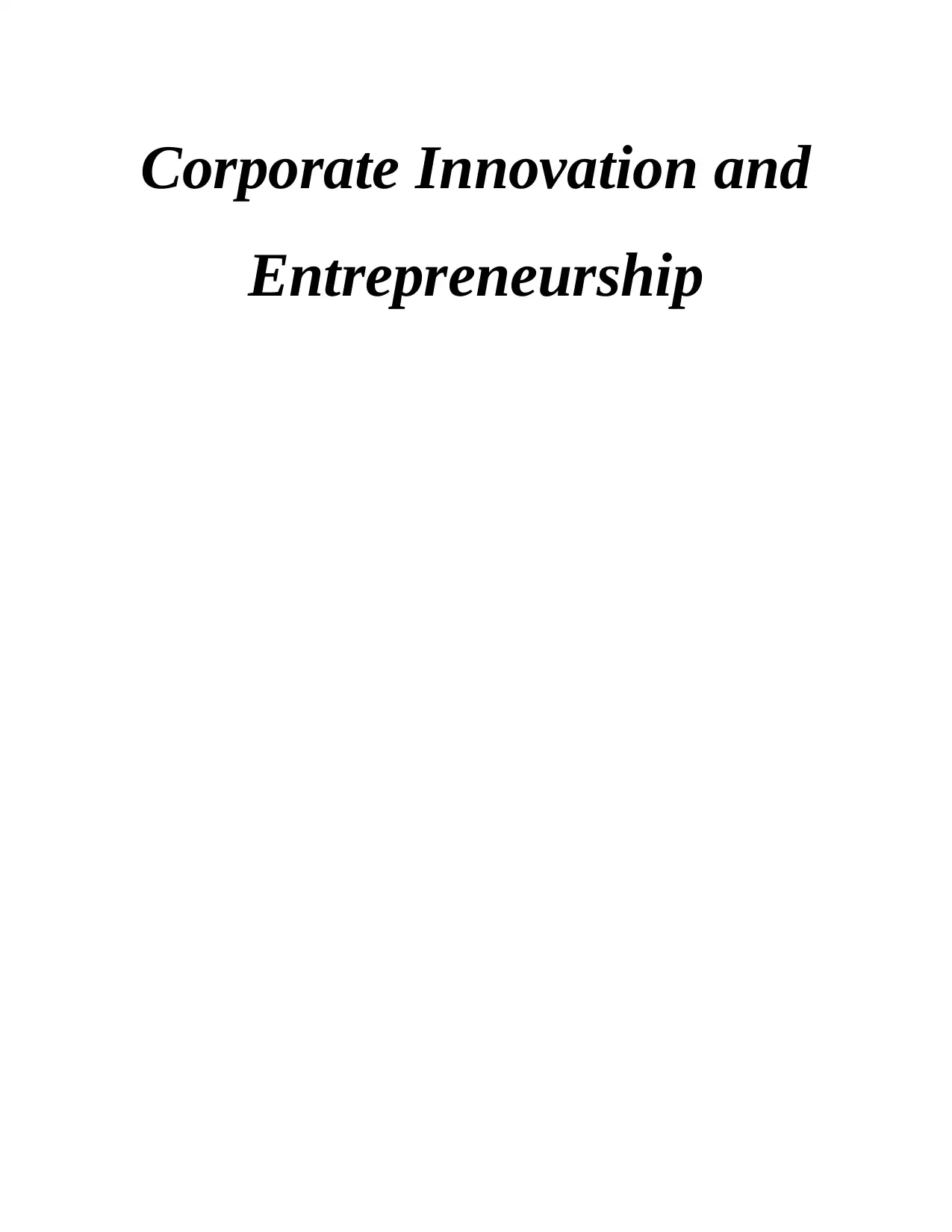
Corporate Innovation and
Entrepreneurship
Entrepreneurship
Paraphrase This Document
Need a fresh take? Get an instant paraphrase of this document with our AI Paraphraser
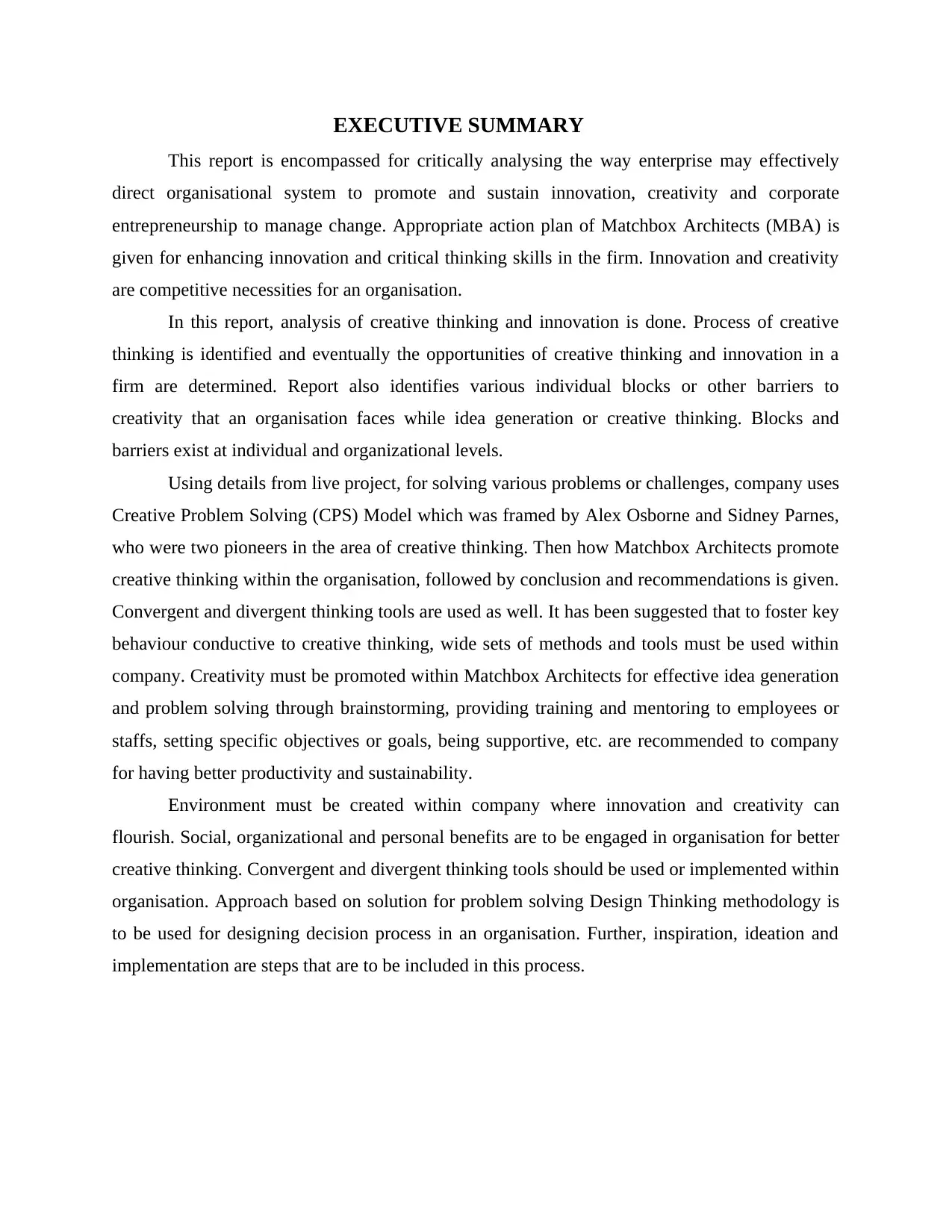
EXECUTIVE SUMMARY
This report is encompassed for critically analysing the way enterprise may effectively
direct organisational system to promote and sustain innovation, creativity and corporate
entrepreneurship to manage change. Appropriate action plan of Matchbox Architects (MBA) is
given for enhancing innovation and critical thinking skills in the firm. Innovation and creativity
are competitive necessities for an organisation.
In this report, analysis of creative thinking and innovation is done. Process of creative
thinking is identified and eventually the opportunities of creative thinking and innovation in a
firm are determined. Report also identifies various individual blocks or other barriers to
creativity that an organisation faces while idea generation or creative thinking. Blocks and
barriers exist at individual and organizational levels.
Using details from live project, for solving various problems or challenges, company uses
Creative Problem Solving (CPS) Model which was framed by Alex Osborne and Sidney Parnes,
who were two pioneers in the area of creative thinking. Then how Matchbox Architects promote
creative thinking within the organisation, followed by conclusion and recommendations is given.
Convergent and divergent thinking tools are used as well. It has been suggested that to foster key
behaviour conductive to creative thinking, wide sets of methods and tools must be used within
company. Creativity must be promoted within Matchbox Architects for effective idea generation
and problem solving through brainstorming, providing training and mentoring to employees or
staffs, setting specific objectives or goals, being supportive, etc. are recommended to company
for having better productivity and sustainability.
Environment must be created within company where innovation and creativity can
flourish. Social, organizational and personal benefits are to be engaged in organisation for better
creative thinking. Convergent and divergent thinking tools should be used or implemented within
organisation. Approach based on solution for problem solving Design Thinking methodology is
to be used for designing decision process in an organisation. Further, inspiration, ideation and
implementation are steps that are to be included in this process.
This report is encompassed for critically analysing the way enterprise may effectively
direct organisational system to promote and sustain innovation, creativity and corporate
entrepreneurship to manage change. Appropriate action plan of Matchbox Architects (MBA) is
given for enhancing innovation and critical thinking skills in the firm. Innovation and creativity
are competitive necessities for an organisation.
In this report, analysis of creative thinking and innovation is done. Process of creative
thinking is identified and eventually the opportunities of creative thinking and innovation in a
firm are determined. Report also identifies various individual blocks or other barriers to
creativity that an organisation faces while idea generation or creative thinking. Blocks and
barriers exist at individual and organizational levels.
Using details from live project, for solving various problems or challenges, company uses
Creative Problem Solving (CPS) Model which was framed by Alex Osborne and Sidney Parnes,
who were two pioneers in the area of creative thinking. Then how Matchbox Architects promote
creative thinking within the organisation, followed by conclusion and recommendations is given.
Convergent and divergent thinking tools are used as well. It has been suggested that to foster key
behaviour conductive to creative thinking, wide sets of methods and tools must be used within
company. Creativity must be promoted within Matchbox Architects for effective idea generation
and problem solving through brainstorming, providing training and mentoring to employees or
staffs, setting specific objectives or goals, being supportive, etc. are recommended to company
for having better productivity and sustainability.
Environment must be created within company where innovation and creativity can
flourish. Social, organizational and personal benefits are to be engaged in organisation for better
creative thinking. Convergent and divergent thinking tools should be used or implemented within
organisation. Approach based on solution for problem solving Design Thinking methodology is
to be used for designing decision process in an organisation. Further, inspiration, ideation and
implementation are steps that are to be included in this process.
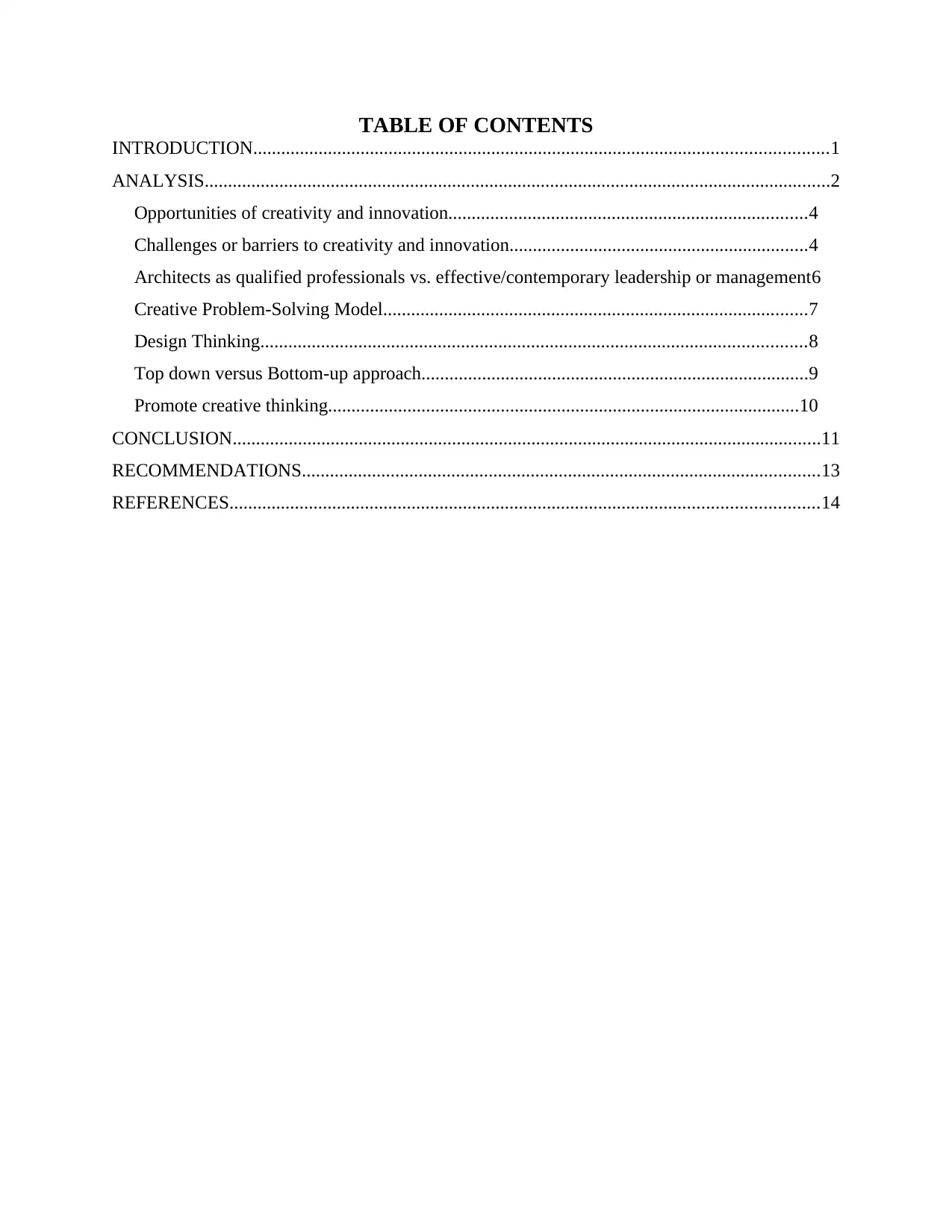
TABLE OF CONTENTS
INTRODUCTION...........................................................................................................................1
ANALYSIS......................................................................................................................................2
Opportunities of creativity and innovation.............................................................................4
Challenges or barriers to creativity and innovation................................................................4
Architects as qualified professionals vs. effective/contemporary leadership or management6
Creative Problem-Solving Model...........................................................................................7
Design Thinking.....................................................................................................................8
Top down versus Bottom-up approach...................................................................................9
Promote creative thinking.....................................................................................................10
CONCLUSION..............................................................................................................................11
RECOMMENDATIONS...............................................................................................................13
REFERENCES..............................................................................................................................14
INTRODUCTION...........................................................................................................................1
ANALYSIS......................................................................................................................................2
Opportunities of creativity and innovation.............................................................................4
Challenges or barriers to creativity and innovation................................................................4
Architects as qualified professionals vs. effective/contemporary leadership or management6
Creative Problem-Solving Model...........................................................................................7
Design Thinking.....................................................................................................................8
Top down versus Bottom-up approach...................................................................................9
Promote creative thinking.....................................................................................................10
CONCLUSION..............................................................................................................................11
RECOMMENDATIONS...............................................................................................................13
REFERENCES..............................................................................................................................14
⊘ This is a preview!⊘
Do you want full access?
Subscribe today to unlock all pages.

Trusted by 1+ million students worldwide
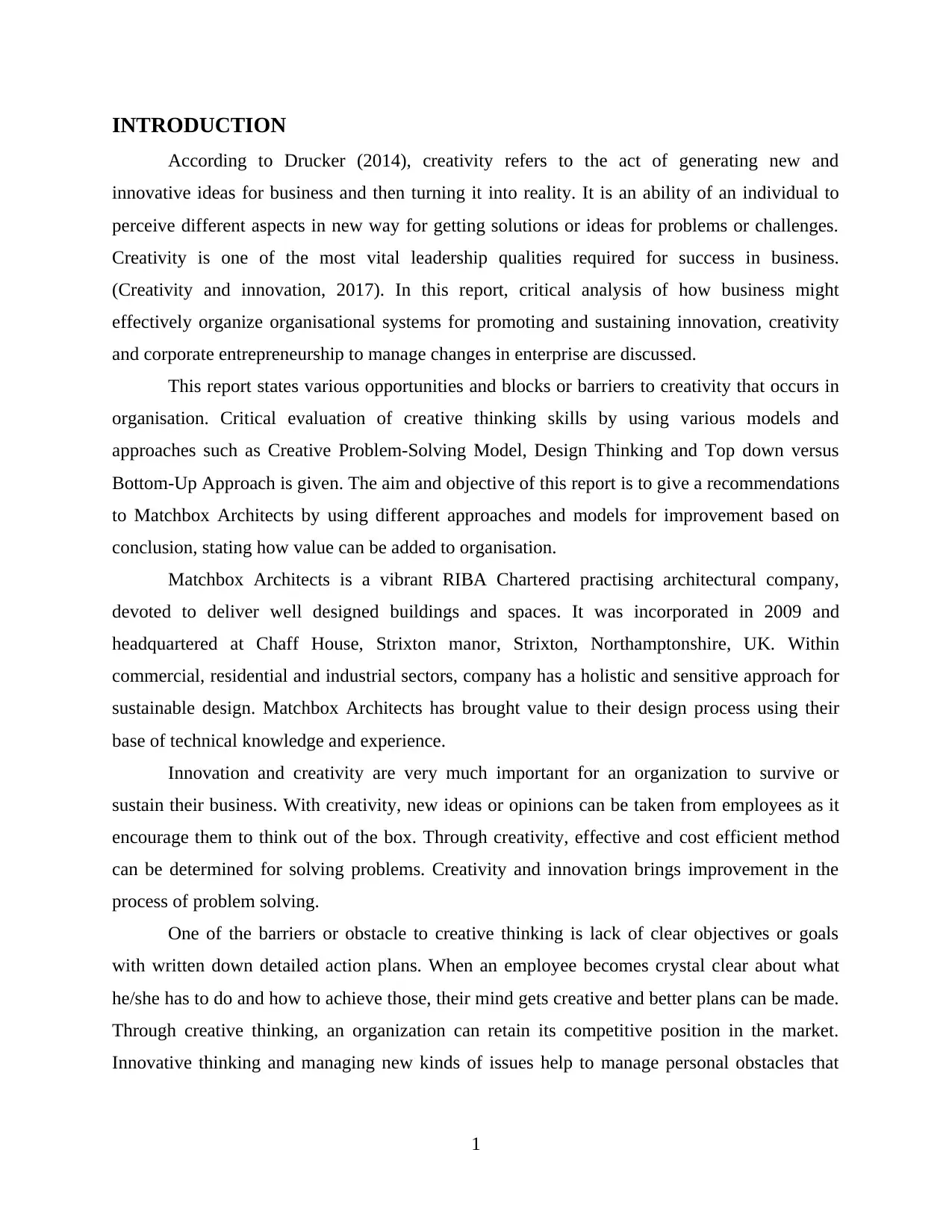
INTRODUCTION
According to Drucker (2014), creativity refers to the act of generating new and
innovative ideas for business and then turning it into reality. It is an ability of an individual to
perceive different aspects in new way for getting solutions or ideas for problems or challenges.
Creativity is one of the most vital leadership qualities required for success in business.
(Creativity and innovation, 2017). In this report, critical analysis of how business might
effectively organize organisational systems for promoting and sustaining innovation, creativity
and corporate entrepreneurship to manage changes in enterprise are discussed.
This report states various opportunities and blocks or barriers to creativity that occurs in
organisation. Critical evaluation of creative thinking skills by using various models and
approaches such as Creative Problem-Solving Model, Design Thinking and Top down versus
Bottom-Up Approach is given. The aim and objective of this report is to give a recommendations
to Matchbox Architects by using different approaches and models for improvement based on
conclusion, stating how value can be added to organisation.
Matchbox Architects is a vibrant RIBA Chartered practising architectural company,
devoted to deliver well designed buildings and spaces. It was incorporated in 2009 and
headquartered at Chaff House, Strixton manor, Strixton, Northamptonshire, UK. Within
commercial, residential and industrial sectors, company has a holistic and sensitive approach for
sustainable design. Matchbox Architects has brought value to their design process using their
base of technical knowledge and experience.
Innovation and creativity are very much important for an organization to survive or
sustain their business. With creativity, new ideas or opinions can be taken from employees as it
encourage them to think out of the box. Through creativity, effective and cost efficient method
can be determined for solving problems. Creativity and innovation brings improvement in the
process of problem solving.
One of the barriers or obstacle to creative thinking is lack of clear objectives or goals
with written down detailed action plans. When an employee becomes crystal clear about what
he/she has to do and how to achieve those, their mind gets creative and better plans can be made.
Through creative thinking, an organization can retain its competitive position in the market.
Innovative thinking and managing new kinds of issues help to manage personal obstacles that
1
According to Drucker (2014), creativity refers to the act of generating new and
innovative ideas for business and then turning it into reality. It is an ability of an individual to
perceive different aspects in new way for getting solutions or ideas for problems or challenges.
Creativity is one of the most vital leadership qualities required for success in business.
(Creativity and innovation, 2017). In this report, critical analysis of how business might
effectively organize organisational systems for promoting and sustaining innovation, creativity
and corporate entrepreneurship to manage changes in enterprise are discussed.
This report states various opportunities and blocks or barriers to creativity that occurs in
organisation. Critical evaluation of creative thinking skills by using various models and
approaches such as Creative Problem-Solving Model, Design Thinking and Top down versus
Bottom-Up Approach is given. The aim and objective of this report is to give a recommendations
to Matchbox Architects by using different approaches and models for improvement based on
conclusion, stating how value can be added to organisation.
Matchbox Architects is a vibrant RIBA Chartered practising architectural company,
devoted to deliver well designed buildings and spaces. It was incorporated in 2009 and
headquartered at Chaff House, Strixton manor, Strixton, Northamptonshire, UK. Within
commercial, residential and industrial sectors, company has a holistic and sensitive approach for
sustainable design. Matchbox Architects has brought value to their design process using their
base of technical knowledge and experience.
Innovation and creativity are very much important for an organization to survive or
sustain their business. With creativity, new ideas or opinions can be taken from employees as it
encourage them to think out of the box. Through creativity, effective and cost efficient method
can be determined for solving problems. Creativity and innovation brings improvement in the
process of problem solving.
One of the barriers or obstacle to creative thinking is lack of clear objectives or goals
with written down detailed action plans. When an employee becomes crystal clear about what
he/she has to do and how to achieve those, their mind gets creative and better plans can be made.
Through creative thinking, an organization can retain its competitive position in the market.
Innovative thinking and managing new kinds of issues help to manage personal obstacles that
1
Paraphrase This Document
Need a fresh take? Get an instant paraphrase of this document with our AI Paraphraser
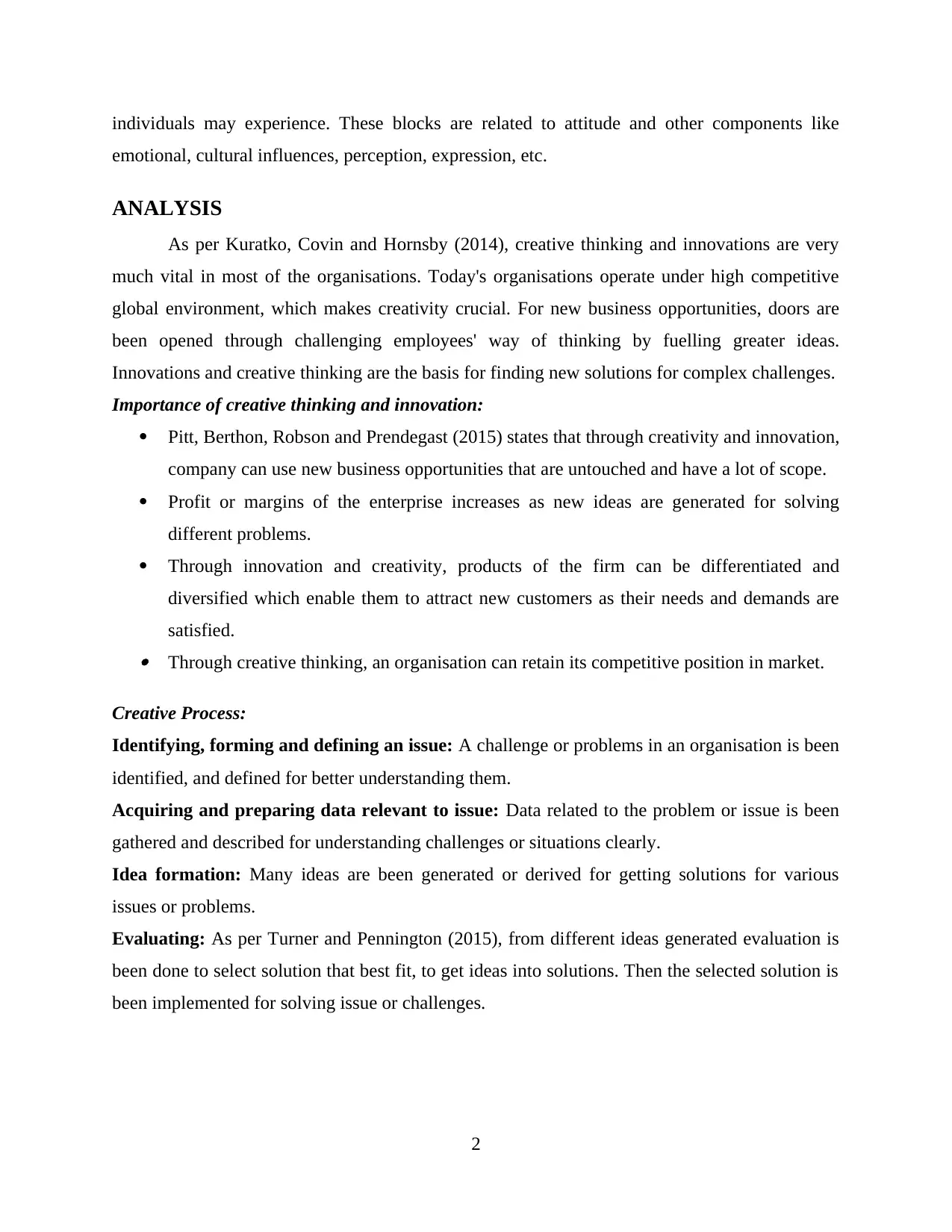
individuals may experience. These blocks are related to attitude and other components like
emotional, cultural influences, perception, expression, etc.
ANALYSIS
As per Kuratko, Covin and Hornsby (2014), creative thinking and innovations are very
much vital in most of the organisations. Today's organisations operate under high competitive
global environment, which makes creativity crucial. For new business opportunities, doors are
been opened through challenging employees' way of thinking by fuelling greater ideas.
Innovations and creative thinking are the basis for finding new solutions for complex challenges.
Importance of creative thinking and innovation:
Pitt, Berthon, Robson and Prendegast (2015) states that through creativity and innovation,
company can use new business opportunities that are untouched and have a lot of scope.
Profit or margins of the enterprise increases as new ideas are generated for solving
different problems.
Through innovation and creativity, products of the firm can be differentiated and
diversified which enable them to attract new customers as their needs and demands are
satisfied. Through creative thinking, an organisation can retain its competitive position in market.
Creative Process:
Identifying, forming and defining an issue: A challenge or problems in an organisation is been
identified, and defined for better understanding them.
Acquiring and preparing data relevant to issue: Data related to the problem or issue is been
gathered and described for understanding challenges or situations clearly.
Idea formation: Many ideas are been generated or derived for getting solutions for various
issues or problems.
Evaluating: As per Turner and Pennington (2015), from different ideas generated evaluation is
been done to select solution that best fit, to get ideas into solutions. Then the selected solution is
been implemented for solving issue or challenges.
2
emotional, cultural influences, perception, expression, etc.
ANALYSIS
As per Kuratko, Covin and Hornsby (2014), creative thinking and innovations are very
much vital in most of the organisations. Today's organisations operate under high competitive
global environment, which makes creativity crucial. For new business opportunities, doors are
been opened through challenging employees' way of thinking by fuelling greater ideas.
Innovations and creative thinking are the basis for finding new solutions for complex challenges.
Importance of creative thinking and innovation:
Pitt, Berthon, Robson and Prendegast (2015) states that through creativity and innovation,
company can use new business opportunities that are untouched and have a lot of scope.
Profit or margins of the enterprise increases as new ideas are generated for solving
different problems.
Through innovation and creativity, products of the firm can be differentiated and
diversified which enable them to attract new customers as their needs and demands are
satisfied. Through creative thinking, an organisation can retain its competitive position in market.
Creative Process:
Identifying, forming and defining an issue: A challenge or problems in an organisation is been
identified, and defined for better understanding them.
Acquiring and preparing data relevant to issue: Data related to the problem or issue is been
gathered and described for understanding challenges or situations clearly.
Idea formation: Many ideas are been generated or derived for getting solutions for various
issues or problems.
Evaluating: As per Turner and Pennington (2015), from different ideas generated evaluation is
been done to select solution that best fit, to get ideas into solutions. Then the selected solution is
been implemented for solving issue or challenges.
2
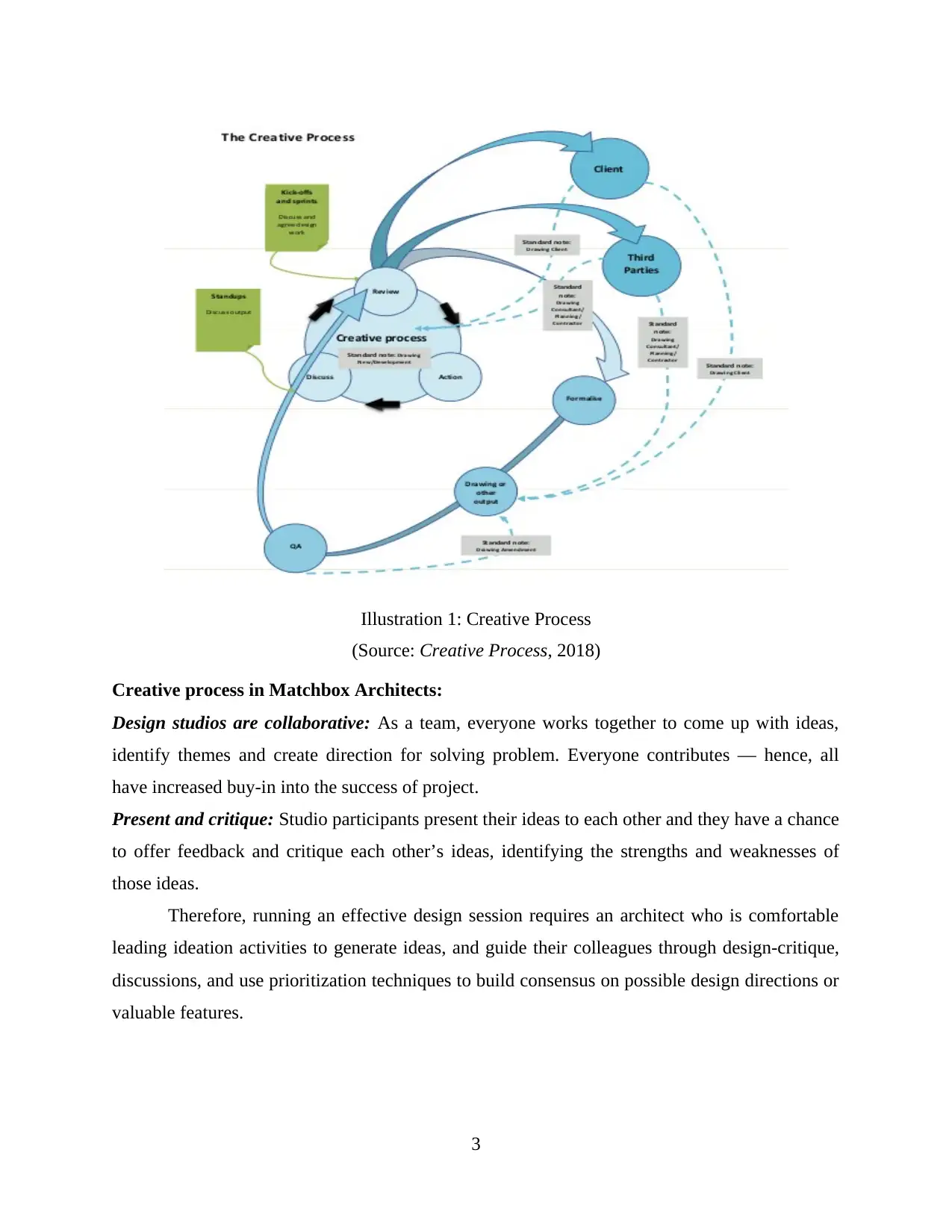
Illustration 1: Creative Process
(Source: Creative Process, 2018)
Creative process in Matchbox Architects:
Design studios are collaborative: As a team, everyone works together to come up with ideas,
identify themes and create direction for solving problem. Everyone contributes — hence, all
have increased buy-in into the success of project.
Present and critique: Studio participants present their ideas to each other and they have a chance
to offer feedback and critique each other’s ideas, identifying the strengths and weaknesses of
those ideas.
Therefore, running an effective design session requires an architect who is comfortable
leading ideation activities to generate ideas, and guide their colleagues through design-critique,
discussions, and use prioritization techniques to build consensus on possible design directions or
valuable features.
3
(Source: Creative Process, 2018)
Creative process in Matchbox Architects:
Design studios are collaborative: As a team, everyone works together to come up with ideas,
identify themes and create direction for solving problem. Everyone contributes — hence, all
have increased buy-in into the success of project.
Present and critique: Studio participants present their ideas to each other and they have a chance
to offer feedback and critique each other’s ideas, identifying the strengths and weaknesses of
those ideas.
Therefore, running an effective design session requires an architect who is comfortable
leading ideation activities to generate ideas, and guide their colleagues through design-critique,
discussions, and use prioritization techniques to build consensus on possible design directions or
valuable features.
3
⊘ This is a preview!⊘
Do you want full access?
Subscribe today to unlock all pages.

Trusted by 1+ million students worldwide

1. Opportunities of creativity and innovation
Improvement of problem solving process: According to Sahut and Peris-Ortiz (2014), creativity
and innovation brings improvement in the process of problem solving. With creativity new ideas
or opinions can be taken from employees, as it encourages them to think out of the box. Through
creativity effective and cost efficient method can be determined for solving problems.
Productivity of business can be increased: Through creativity and innovation new out of the box
ideas and perspectives can be generated, which would help in to develop new product or
services. This would attract customers towards latest innovative product or services, that would
leads to increase in productivity of enterprise and maximizes profitability.
Gives competitive edge: As per Chemmanur and Tian (2018), innovation and creativity provides
a competitive edge to an organisation, that every enterprises are striving to attain. Innovation and
creativity would make them stand out from their competitors in market and to achieve or retain
their position.
2. Challenges or barriers to creativity and innovation
There are various blocks to innovation and creativity, which are as follows:
Individual Blocks: For individuals, critical thinking and innovative considering don't fall
quickly into place. There are pieces to innovative critical thinking and considering imaginative,
on account of people. According to Yunis, Tarhini and Kassar (2018), innovatively thinking and
managing new form issues helps to manage personal obstacles that individual may experience.
These blocks are related to attitude and other components like emotion, cultural influences,
perception, expression, etc.
Matchbox Architects (MBA) promotes creativity thinking for new start-up projects, by
eliminating individual blocks which are faced by staffs.
There are certain individual blocks such as: Emotional, cultural, perceptual, false assumption,
self-image, focus/distraction, mind-set, values, etc.
People blocks: Most of the barriers in creativity and innovation come from other persons. A
person easily leads to evaluating others and their ideas, due to the nature of being judgemental
and competitive, even knowing the destructive effect it would have on them. If a person don't
trust their co-workers, it would become tricky for group creativity (Drucker, 2014).
Cause:
Lack of trust
4
Improvement of problem solving process: According to Sahut and Peris-Ortiz (2014), creativity
and innovation brings improvement in the process of problem solving. With creativity new ideas
or opinions can be taken from employees, as it encourages them to think out of the box. Through
creativity effective and cost efficient method can be determined for solving problems.
Productivity of business can be increased: Through creativity and innovation new out of the box
ideas and perspectives can be generated, which would help in to develop new product or
services. This would attract customers towards latest innovative product or services, that would
leads to increase in productivity of enterprise and maximizes profitability.
Gives competitive edge: As per Chemmanur and Tian (2018), innovation and creativity provides
a competitive edge to an organisation, that every enterprises are striving to attain. Innovation and
creativity would make them stand out from their competitors in market and to achieve or retain
their position.
2. Challenges or barriers to creativity and innovation
There are various blocks to innovation and creativity, which are as follows:
Individual Blocks: For individuals, critical thinking and innovative considering don't fall
quickly into place. There are pieces to innovative critical thinking and considering imaginative,
on account of people. According to Yunis, Tarhini and Kassar (2018), innovatively thinking and
managing new form issues helps to manage personal obstacles that individual may experience.
These blocks are related to attitude and other components like emotion, cultural influences,
perception, expression, etc.
Matchbox Architects (MBA) promotes creativity thinking for new start-up projects, by
eliminating individual blocks which are faced by staffs.
There are certain individual blocks such as: Emotional, cultural, perceptual, false assumption,
self-image, focus/distraction, mind-set, values, etc.
People blocks: Most of the barriers in creativity and innovation come from other persons. A
person easily leads to evaluating others and their ideas, due to the nature of being judgemental
and competitive, even knowing the destructive effect it would have on them. If a person don't
trust their co-workers, it would become tricky for group creativity (Drucker, 2014).
Cause:
Lack of trust
4
Paraphrase This Document
Need a fresh take? Get an instant paraphrase of this document with our AI Paraphraser
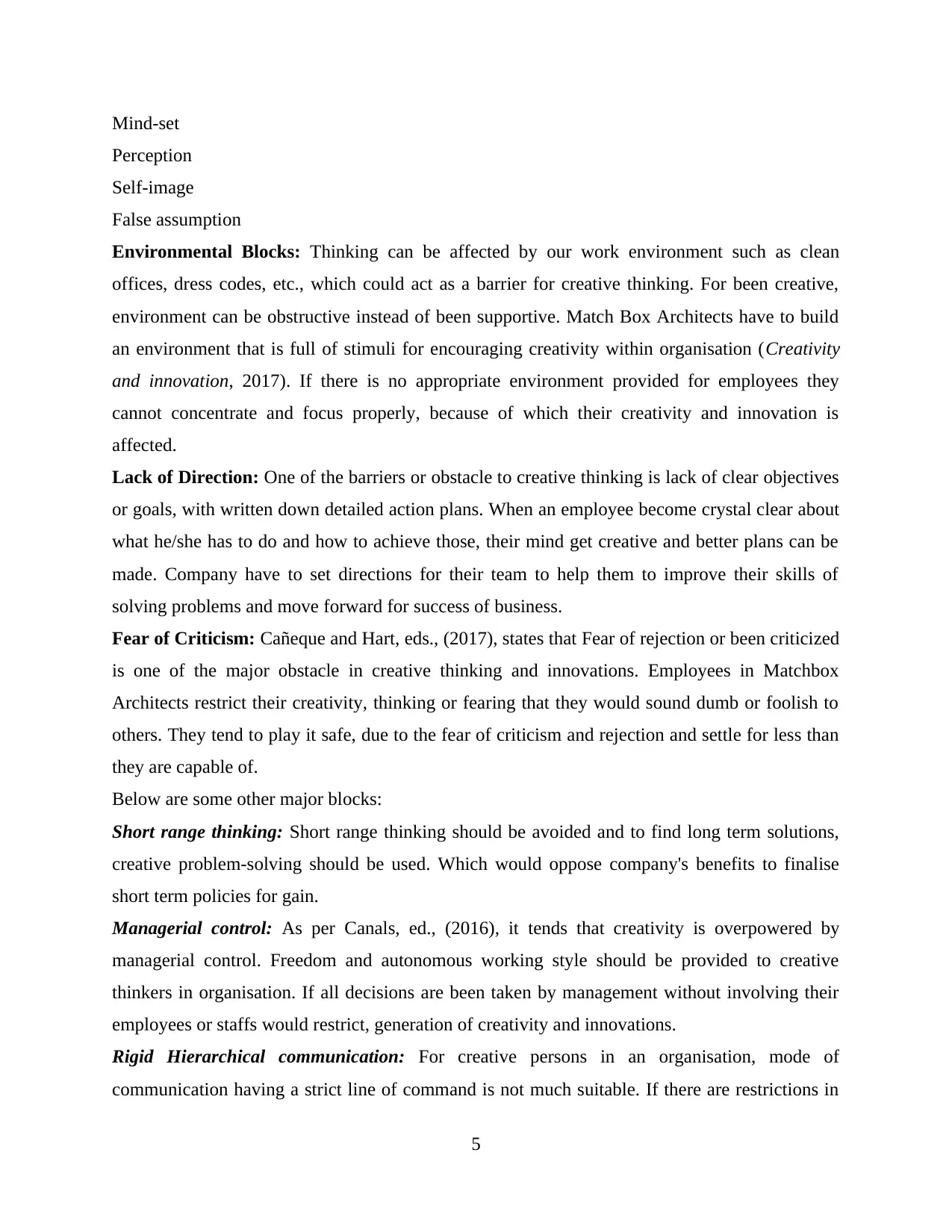
Mind-set
Perception
Self-image
False assumption
Environmental Blocks: Thinking can be affected by our work environment such as clean
offices, dress codes, etc., which could act as a barrier for creative thinking. For been creative,
environment can be obstructive instead of been supportive. Match Box Architects have to build
an environment that is full of stimuli for encouraging creativity within organisation (Creativity
and innovation, 2017). If there is no appropriate environment provided for employees they
cannot concentrate and focus properly, because of which their creativity and innovation is
affected.
Lack of Direction: One of the barriers or obstacle to creative thinking is lack of clear objectives
or goals, with written down detailed action plans. When an employee become crystal clear about
what he/she has to do and how to achieve those, their mind get creative and better plans can be
made. Company have to set directions for their team to help them to improve their skills of
solving problems and move forward for success of business.
Fear of Criticism: Cañeque and Hart, eds., (2017), states that Fear of rejection or been criticized
is one of the major obstacle in creative thinking and innovations. Employees in Matchbox
Architects restrict their creativity, thinking or fearing that they would sound dumb or foolish to
others. They tend to play it safe, due to the fear of criticism and rejection and settle for less than
they are capable of.
Below are some other major blocks:
Short range thinking: Short range thinking should be avoided and to find long term solutions,
creative problem-solving should be used. Which would oppose company's benefits to finalise
short term policies for gain.
Managerial control: As per Canals, ed., (2016), it tends that creativity is overpowered by
managerial control. Freedom and autonomous working style should be provided to creative
thinkers in organisation. If all decisions are been taken by management without involving their
employees or staffs would restrict, generation of creativity and innovations.
Rigid Hierarchical communication: For creative persons in an organisation, mode of
communication having a strict line of command is not much suitable. If there are restrictions in
5
Perception
Self-image
False assumption
Environmental Blocks: Thinking can be affected by our work environment such as clean
offices, dress codes, etc., which could act as a barrier for creative thinking. For been creative,
environment can be obstructive instead of been supportive. Match Box Architects have to build
an environment that is full of stimuli for encouraging creativity within organisation (Creativity
and innovation, 2017). If there is no appropriate environment provided for employees they
cannot concentrate and focus properly, because of which their creativity and innovation is
affected.
Lack of Direction: One of the barriers or obstacle to creative thinking is lack of clear objectives
or goals, with written down detailed action plans. When an employee become crystal clear about
what he/she has to do and how to achieve those, their mind get creative and better plans can be
made. Company have to set directions for their team to help them to improve their skills of
solving problems and move forward for success of business.
Fear of Criticism: Cañeque and Hart, eds., (2017), states that Fear of rejection or been criticized
is one of the major obstacle in creative thinking and innovations. Employees in Matchbox
Architects restrict their creativity, thinking or fearing that they would sound dumb or foolish to
others. They tend to play it safe, due to the fear of criticism and rejection and settle for less than
they are capable of.
Below are some other major blocks:
Short range thinking: Short range thinking should be avoided and to find long term solutions,
creative problem-solving should be used. Which would oppose company's benefits to finalise
short term policies for gain.
Managerial control: As per Canals, ed., (2016), it tends that creativity is overpowered by
managerial control. Freedom and autonomous working style should be provided to creative
thinkers in organisation. If all decisions are been taken by management without involving their
employees or staffs would restrict, generation of creativity and innovations.
Rigid Hierarchical communication: For creative persons in an organisation, mode of
communication having a strict line of command is not much suitable. If there are restrictions in
5
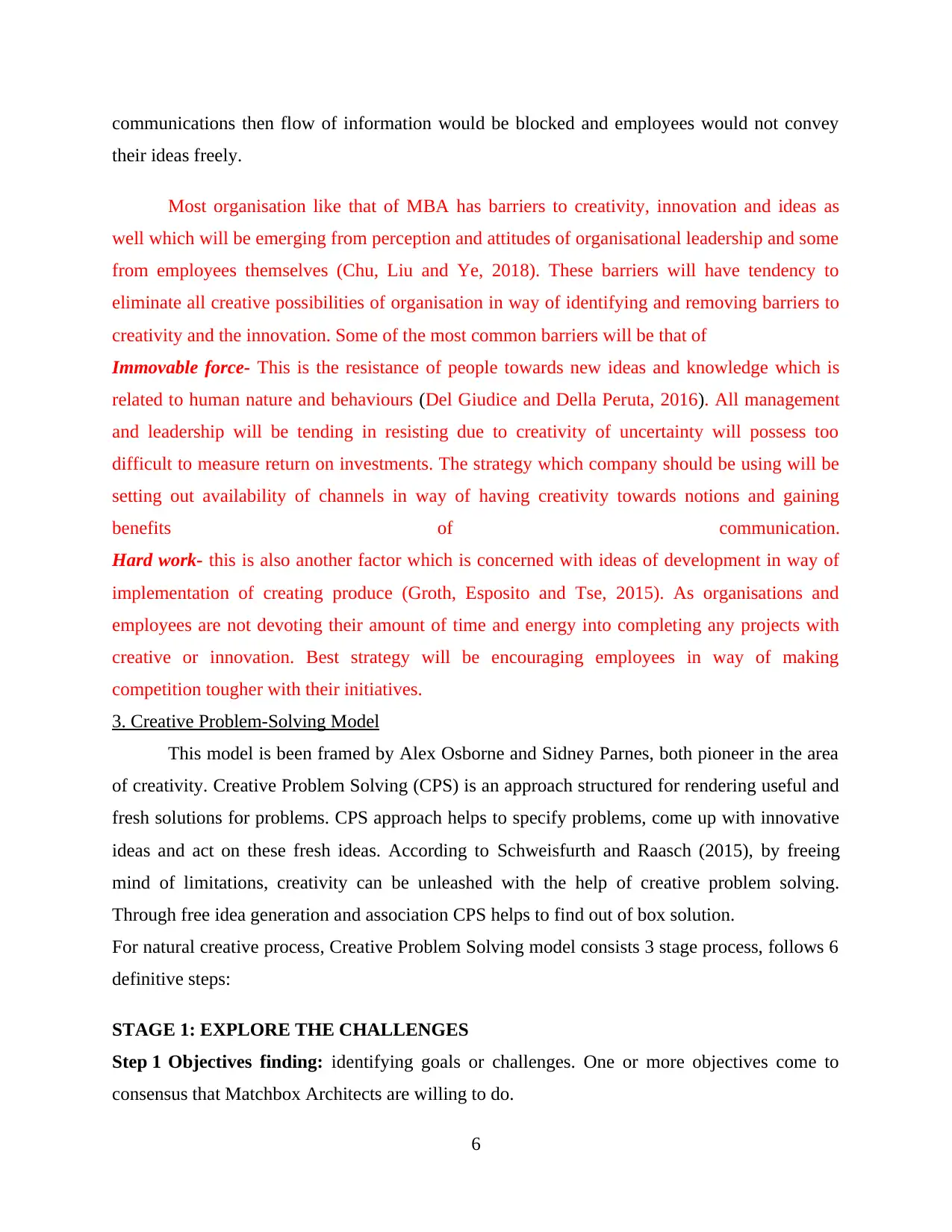
communications then flow of information would be blocked and employees would not convey
their ideas freely.
Most organisation like that of MBA has barriers to creativity, innovation and ideas as
well which will be emerging from perception and attitudes of organisational leadership and some
from employees themselves (Chu, Liu and Ye, 2018). These barriers will have tendency to
eliminate all creative possibilities of organisation in way of identifying and removing barriers to
creativity and the innovation. Some of the most common barriers will be that of
Immovable force- This is the resistance of people towards new ideas and knowledge which is
related to human nature and behaviours (Del Giudice and Della Peruta, 2016). All management
and leadership will be tending in resisting due to creativity of uncertainty will possess too
difficult to measure return on investments. The strategy which company should be using will be
setting out availability of channels in way of having creativity towards notions and gaining
benefits of communication.
Hard work- this is also another factor which is concerned with ideas of development in way of
implementation of creating produce (Groth, Esposito and Tse, 2015). As organisations and
employees are not devoting their amount of time and energy into completing any projects with
creative or innovation. Best strategy will be encouraging employees in way of making
competition tougher with their initiatives.
3. Creative Problem-Solving Model
This model is been framed by Alex Osborne and Sidney Parnes, both pioneer in the area
of creativity. Creative Problem Solving (CPS) is an approach structured for rendering useful and
fresh solutions for problems. CPS approach helps to specify problems, come up with innovative
ideas and act on these fresh ideas. According to Schweisfurth and Raasch (2015), by freeing
mind of limitations, creativity can be unleashed with the help of creative problem solving.
Through free idea generation and association CPS helps to find out of box solution.
For natural creative process, Creative Problem Solving model consists 3 stage process, follows 6
definitive steps:
STAGE 1: EXPLORE THE CHALLENGES
Step 1 Objectives finding: identifying goals or challenges. One or more objectives come to
consensus that Matchbox Architects are willing to do.
6
their ideas freely.
Most organisation like that of MBA has barriers to creativity, innovation and ideas as
well which will be emerging from perception and attitudes of organisational leadership and some
from employees themselves (Chu, Liu and Ye, 2018). These barriers will have tendency to
eliminate all creative possibilities of organisation in way of identifying and removing barriers to
creativity and the innovation. Some of the most common barriers will be that of
Immovable force- This is the resistance of people towards new ideas and knowledge which is
related to human nature and behaviours (Del Giudice and Della Peruta, 2016). All management
and leadership will be tending in resisting due to creativity of uncertainty will possess too
difficult to measure return on investments. The strategy which company should be using will be
setting out availability of channels in way of having creativity towards notions and gaining
benefits of communication.
Hard work- this is also another factor which is concerned with ideas of development in way of
implementation of creating produce (Groth, Esposito and Tse, 2015). As organisations and
employees are not devoting their amount of time and energy into completing any projects with
creative or innovation. Best strategy will be encouraging employees in way of making
competition tougher with their initiatives.
3. Creative Problem-Solving Model
This model is been framed by Alex Osborne and Sidney Parnes, both pioneer in the area
of creativity. Creative Problem Solving (CPS) is an approach structured for rendering useful and
fresh solutions for problems. CPS approach helps to specify problems, come up with innovative
ideas and act on these fresh ideas. According to Schweisfurth and Raasch (2015), by freeing
mind of limitations, creativity can be unleashed with the help of creative problem solving.
Through free idea generation and association CPS helps to find out of box solution.
For natural creative process, Creative Problem Solving model consists 3 stage process, follows 6
definitive steps:
STAGE 1: EXPLORE THE CHALLENGES
Step 1 Objectives finding: identifying goals or challenges. One or more objectives come to
consensus that Matchbox Architects are willing to do.
6
⊘ This is a preview!⊘
Do you want full access?
Subscribe today to unlock all pages.

Trusted by 1+ million students worldwide
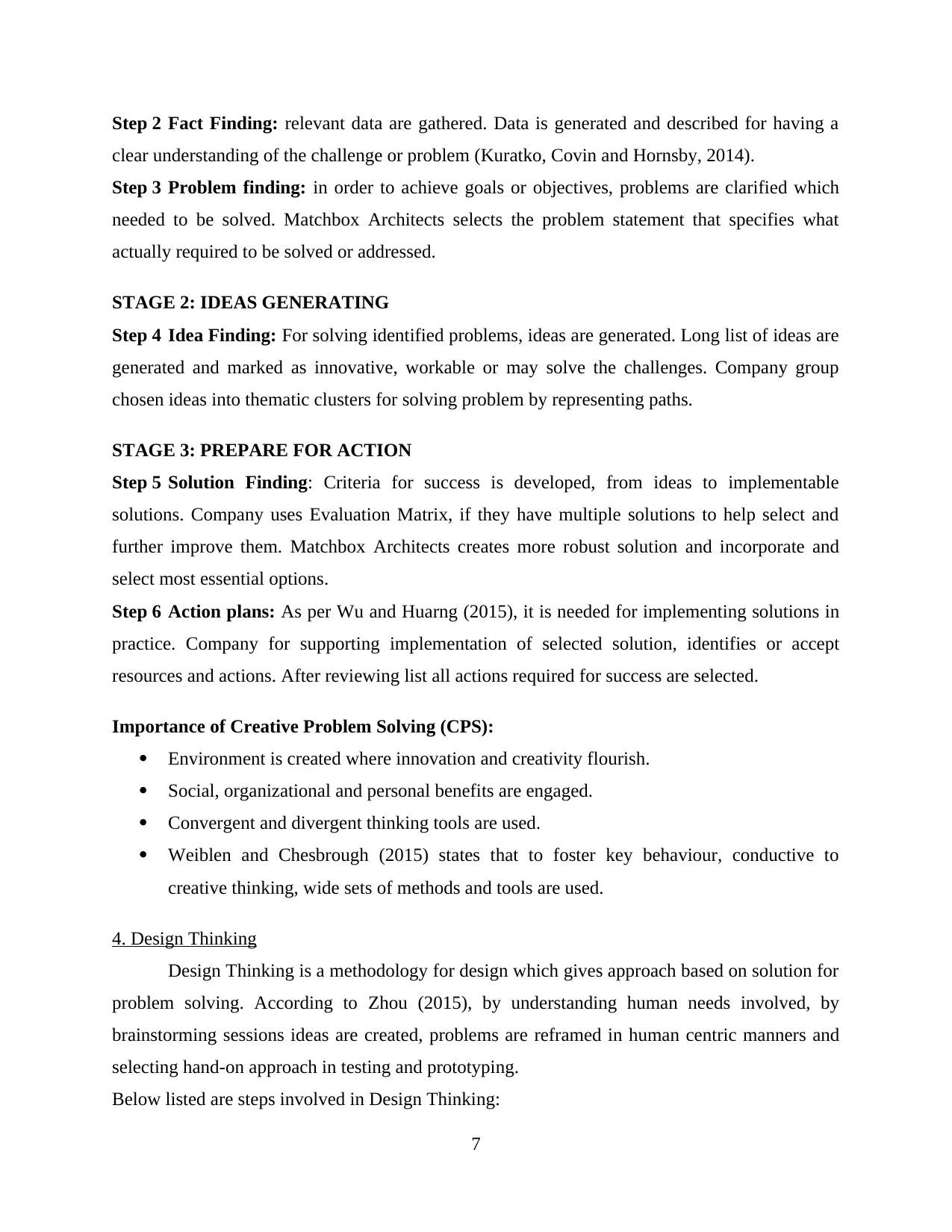
Step 2 Fact Finding: relevant data are gathered. Data is generated and described for having a
clear understanding of the challenge or problem (Kuratko, Covin and Hornsby, 2014).
Step 3 Problem finding: in order to achieve goals or objectives, problems are clarified which
needed to be solved. Matchbox Architects selects the problem statement that specifies what
actually required to be solved or addressed.
STAGE 2: IDEAS GENERATING
Step 4 Idea Finding: For solving identified problems, ideas are generated. Long list of ideas are
generated and marked as innovative, workable or may solve the challenges. Company group
chosen ideas into thematic clusters for solving problem by representing paths.
STAGE 3: PREPARE FOR ACTION
Step 5 Solution Finding: Criteria for success is developed, from ideas to implementable
solutions. Company uses Evaluation Matrix, if they have multiple solutions to help select and
further improve them. Matchbox Architects creates more robust solution and incorporate and
select most essential options.
Step 6 Action plans: As per Wu and Huarng (2015), it is needed for implementing solutions in
practice. Company for supporting implementation of selected solution, identifies or accept
resources and actions. After reviewing list all actions required for success are selected.
Importance of Creative Problem Solving (CPS):
Environment is created where innovation and creativity flourish.
Social, organizational and personal benefits are engaged.
Convergent and divergent thinking tools are used.
Weiblen and Chesbrough (2015) states that to foster key behaviour, conductive to
creative thinking, wide sets of methods and tools are used.
4. Design Thinking
Design Thinking is a methodology for design which gives approach based on solution for
problem solving. According to Zhou (2015), by understanding human needs involved, by
brainstorming sessions ideas are created, problems are reframed in human centric manners and
selecting hand-on approach in testing and prototyping.
Below listed are steps involved in Design Thinking:
7
clear understanding of the challenge or problem (Kuratko, Covin and Hornsby, 2014).
Step 3 Problem finding: in order to achieve goals or objectives, problems are clarified which
needed to be solved. Matchbox Architects selects the problem statement that specifies what
actually required to be solved or addressed.
STAGE 2: IDEAS GENERATING
Step 4 Idea Finding: For solving identified problems, ideas are generated. Long list of ideas are
generated and marked as innovative, workable or may solve the challenges. Company group
chosen ideas into thematic clusters for solving problem by representing paths.
STAGE 3: PREPARE FOR ACTION
Step 5 Solution Finding: Criteria for success is developed, from ideas to implementable
solutions. Company uses Evaluation Matrix, if they have multiple solutions to help select and
further improve them. Matchbox Architects creates more robust solution and incorporate and
select most essential options.
Step 6 Action plans: As per Wu and Huarng (2015), it is needed for implementing solutions in
practice. Company for supporting implementation of selected solution, identifies or accept
resources and actions. After reviewing list all actions required for success are selected.
Importance of Creative Problem Solving (CPS):
Environment is created where innovation and creativity flourish.
Social, organizational and personal benefits are engaged.
Convergent and divergent thinking tools are used.
Weiblen and Chesbrough (2015) states that to foster key behaviour, conductive to
creative thinking, wide sets of methods and tools are used.
4. Design Thinking
Design Thinking is a methodology for design which gives approach based on solution for
problem solving. According to Zhou (2015), by understanding human needs involved, by
brainstorming sessions ideas are created, problems are reframed in human centric manners and
selecting hand-on approach in testing and prototyping.
Below listed are steps involved in Design Thinking:
7
Paraphrase This Document
Need a fresh take? Get an instant paraphrase of this document with our AI Paraphraser
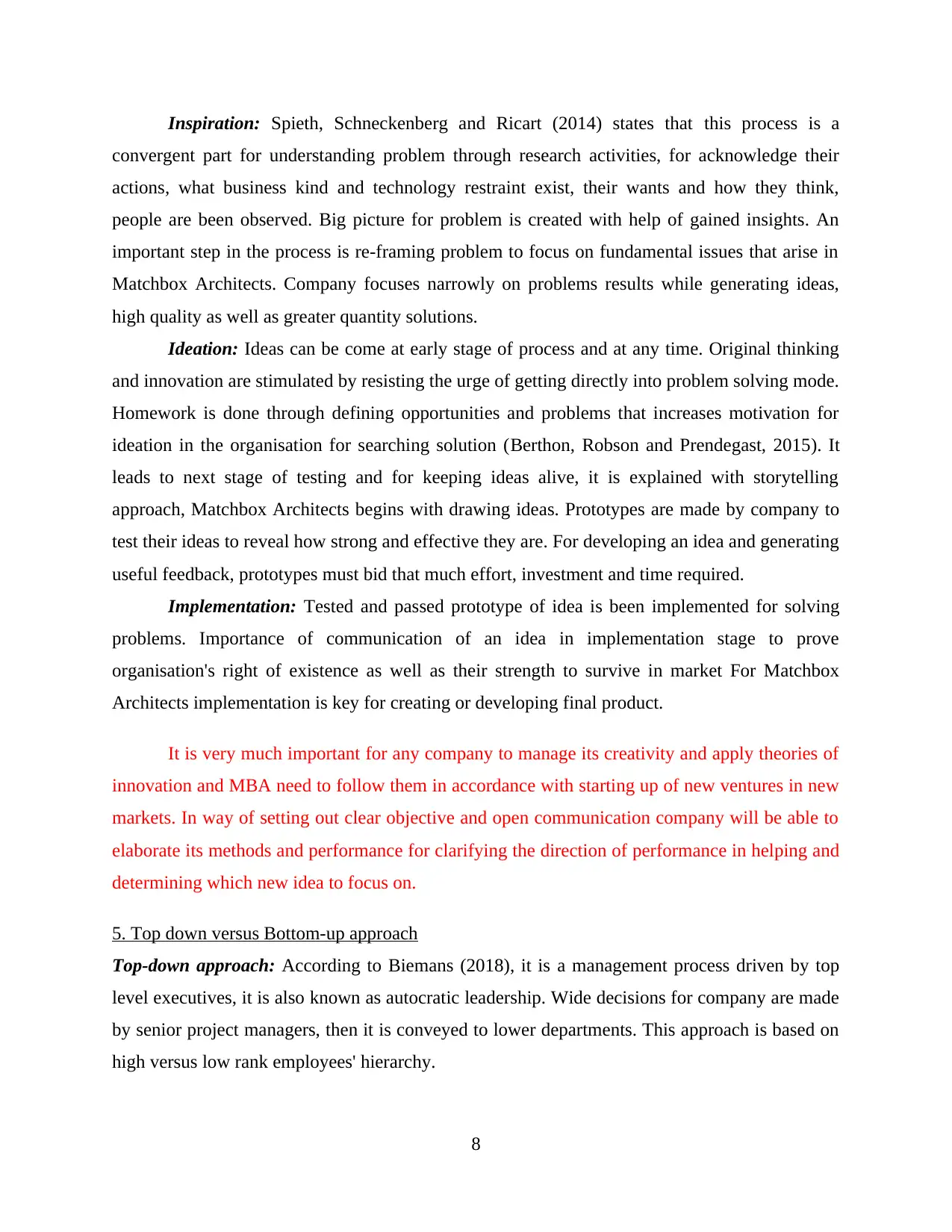
Inspiration: Spieth, Schneckenberg and Ricart (2014) states that this process is a
convergent part for understanding problem through research activities, for acknowledge their
actions, what business kind and technology restraint exist, their wants and how they think,
people are been observed. Big picture for problem is created with help of gained insights. An
important step in the process is re-framing problem to focus on fundamental issues that arise in
Matchbox Architects. Company focuses narrowly on problems results while generating ideas,
high quality as well as greater quantity solutions.
Ideation: Ideas can be come at early stage of process and at any time. Original thinking
and innovation are stimulated by resisting the urge of getting directly into problem solving mode.
Homework is done through defining opportunities and problems that increases motivation for
ideation in the organisation for searching solution (Berthon, Robson and Prendegast, 2015). It
leads to next stage of testing and for keeping ideas alive, it is explained with storytelling
approach, Matchbox Architects begins with drawing ideas. Prototypes are made by company to
test their ideas to reveal how strong and effective they are. For developing an idea and generating
useful feedback, prototypes must bid that much effort, investment and time required.
Implementation: Tested and passed prototype of idea is been implemented for solving
problems. Importance of communication of an idea in implementation stage to prove
organisation's right of existence as well as their strength to survive in market For Matchbox
Architects implementation is key for creating or developing final product.
It is very much important for any company to manage its creativity and apply theories of
innovation and MBA need to follow them in accordance with starting up of new ventures in new
markets. In way of setting out clear objective and open communication company will be able to
elaborate its methods and performance for clarifying the direction of performance in helping and
determining which new idea to focus on.
5. Top down versus Bottom-up approach
Top-down approach: According to Biemans (2018), it is a management process driven by top
level executives, it is also known as autocratic leadership. Wide decisions for company are made
by senior project managers, then it is conveyed to lower departments. This approach is based on
high versus low rank employees' hierarchy.
8
convergent part for understanding problem through research activities, for acknowledge their
actions, what business kind and technology restraint exist, their wants and how they think,
people are been observed. Big picture for problem is created with help of gained insights. An
important step in the process is re-framing problem to focus on fundamental issues that arise in
Matchbox Architects. Company focuses narrowly on problems results while generating ideas,
high quality as well as greater quantity solutions.
Ideation: Ideas can be come at early stage of process and at any time. Original thinking
and innovation are stimulated by resisting the urge of getting directly into problem solving mode.
Homework is done through defining opportunities and problems that increases motivation for
ideation in the organisation for searching solution (Berthon, Robson and Prendegast, 2015). It
leads to next stage of testing and for keeping ideas alive, it is explained with storytelling
approach, Matchbox Architects begins with drawing ideas. Prototypes are made by company to
test their ideas to reveal how strong and effective they are. For developing an idea and generating
useful feedback, prototypes must bid that much effort, investment and time required.
Implementation: Tested and passed prototype of idea is been implemented for solving
problems. Importance of communication of an idea in implementation stage to prove
organisation's right of existence as well as their strength to survive in market For Matchbox
Architects implementation is key for creating or developing final product.
It is very much important for any company to manage its creativity and apply theories of
innovation and MBA need to follow them in accordance with starting up of new ventures in new
markets. In way of setting out clear objective and open communication company will be able to
elaborate its methods and performance for clarifying the direction of performance in helping and
determining which new idea to focus on.
5. Top down versus Bottom-up approach
Top-down approach: According to Biemans (2018), it is a management process driven by top
level executives, it is also known as autocratic leadership. Wide decisions for company are made
by senior project managers, then it is conveyed to lower departments. This approach is based on
high versus low rank employees' hierarchy.
8
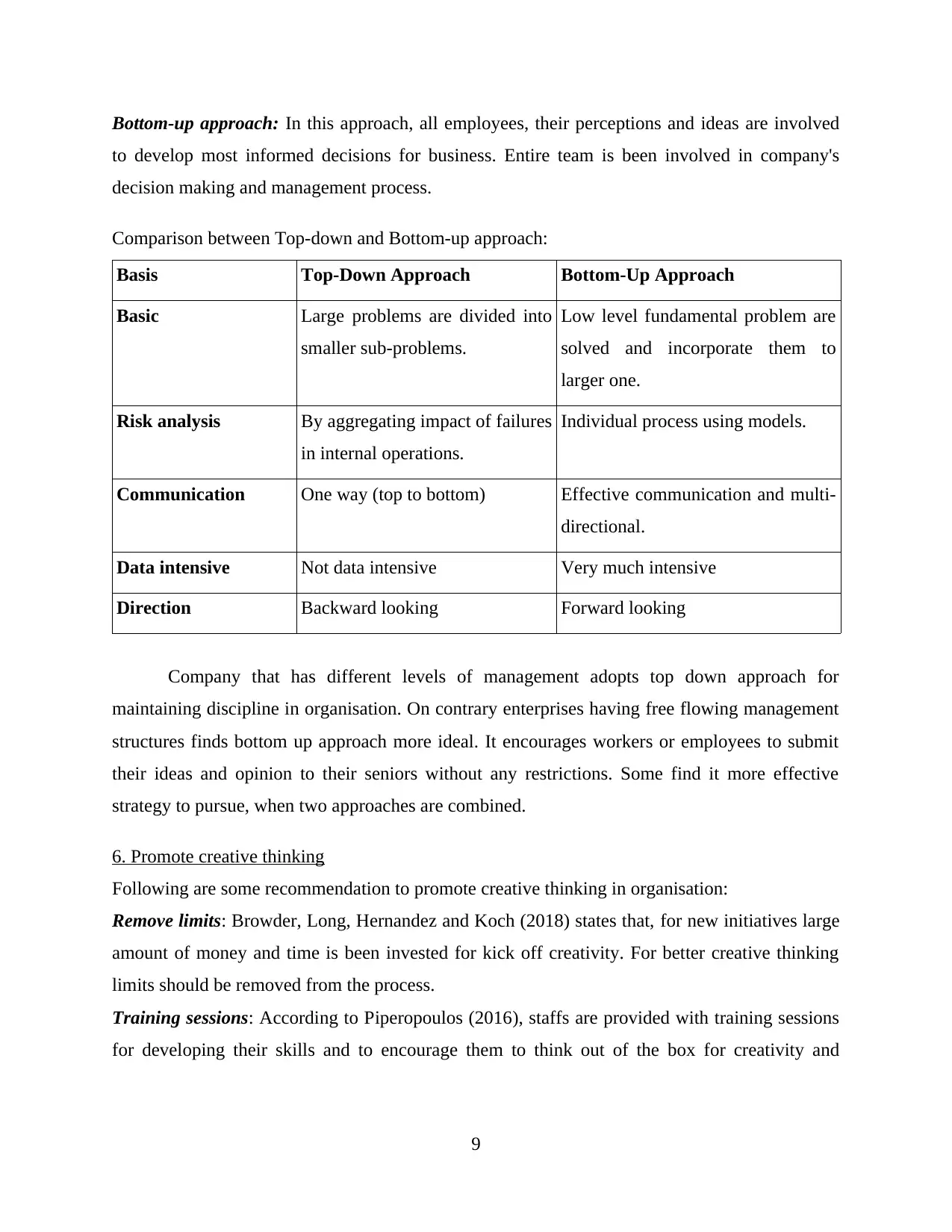
Bottom-up approach: In this approach, all employees, their perceptions and ideas are involved
to develop most informed decisions for business. Entire team is been involved in company's
decision making and management process.
Comparison between Top-down and Bottom-up approach:
Basis Top-Down Approach Bottom-Up Approach
Basic Large problems are divided into
smaller sub-problems.
Low level fundamental problem are
solved and incorporate them to
larger one.
Risk analysis By aggregating impact of failures
in internal operations.
Individual process using models.
Communication One way (top to bottom) Effective communication and multi-
directional.
Data intensive Not data intensive Very much intensive
Direction Backward looking Forward looking
Company that has different levels of management adopts top down approach for
maintaining discipline in organisation. On contrary enterprises having free flowing management
structures finds bottom up approach more ideal. It encourages workers or employees to submit
their ideas and opinion to their seniors without any restrictions. Some find it more effective
strategy to pursue, when two approaches are combined.
6. Promote creative thinking
Following are some recommendation to promote creative thinking in organisation:
Remove limits: Browder, Long, Hernandez and Koch (2018) states that, for new initiatives large
amount of money and time is been invested for kick off creativity. For better creative thinking
limits should be removed from the process.
Training sessions: According to Piperopoulos (2016), staffs are provided with training sessions
for developing their skills and to encourage them to think out of the box for creativity and
9
to develop most informed decisions for business. Entire team is been involved in company's
decision making and management process.
Comparison between Top-down and Bottom-up approach:
Basis Top-Down Approach Bottom-Up Approach
Basic Large problems are divided into
smaller sub-problems.
Low level fundamental problem are
solved and incorporate them to
larger one.
Risk analysis By aggregating impact of failures
in internal operations.
Individual process using models.
Communication One way (top to bottom) Effective communication and multi-
directional.
Data intensive Not data intensive Very much intensive
Direction Backward looking Forward looking
Company that has different levels of management adopts top down approach for
maintaining discipline in organisation. On contrary enterprises having free flowing management
structures finds bottom up approach more ideal. It encourages workers or employees to submit
their ideas and opinion to their seniors without any restrictions. Some find it more effective
strategy to pursue, when two approaches are combined.
6. Promote creative thinking
Following are some recommendation to promote creative thinking in organisation:
Remove limits: Browder, Long, Hernandez and Koch (2018) states that, for new initiatives large
amount of money and time is been invested for kick off creativity. For better creative thinking
limits should be removed from the process.
Training sessions: According to Piperopoulos (2016), staffs are provided with training sessions
for developing their skills and to encourage them to think out of the box for creativity and
9
⊘ This is a preview!⊘
Do you want full access?
Subscribe today to unlock all pages.

Trusted by 1+ million students worldwide
1 out of 17
Related Documents
Your All-in-One AI-Powered Toolkit for Academic Success.
+13062052269
info@desklib.com
Available 24*7 on WhatsApp / Email
![[object Object]](/_next/static/media/star-bottom.7253800d.svg)
Unlock your academic potential
Copyright © 2020–2025 A2Z Services. All Rights Reserved. Developed and managed by ZUCOL.





